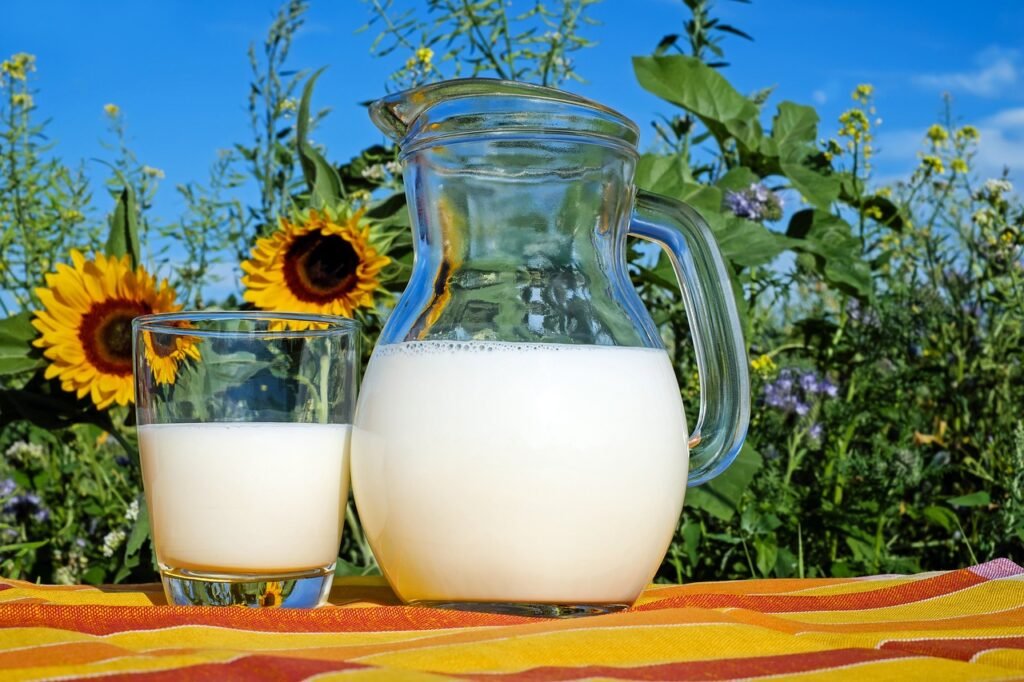Protein shakes can be a great way to supplement your diet and get the nutrients you need, but if that shake is made with cow’s milk, you may not be getting all of the benefits it has to offer. On the other hand, almond milk could provide some much-needed protein without all of the extra calories.
So what should you choose – almond or cow’s milk? In this blog post, we’ll explore both options in greater detail so that you can make an informed decision about which one is best for your protein shake!

We’ll look at nutritional values, taste preferences and more so that no matter how picky your palate is or what nutrition goals you have set for yourself – there’s bound to be something here for everyone. Let’s dive in – let’s compare almond milk vs. cow’s milk today!
An Overview of Almond Milk and Its Benefits for Protein Shakes
Almond milk is a plant-based alternative to traditional cow’s milk, well-known for its light, nutty flavor and creamy consistency that perfectly complements protein shakes. It’s low in calories and sugar, making it a favorite choice for those who are mindful of their dietary intake.

What sets almond milk apart is its high vitamin E content, an antioxidant that promotes healthy skin and boosts immunity. It’s also rich in calcium, which is essential for bone health.
Although almond milk has slightly less protein content than cow’s milk, it is still a viable alternative for those with lactose intolerance or those following a vegan diet. When used in protein shakes, almond milk adds a refreshing taste without the additional calories, making your post-workout drink a delicious and nutritious treat.
A Closer Look at Cow’s Milk and Its Nutritional Value
Cow’s milk is a traditional choice for protein shakes, largely due to its high protein content. A cup of whole cow’s milk typically offers around 8 grams of protein, which is nearly double the protein content found in an equivalent amount of almond milk.

This makes it a compelling choice for those specifically seeking to increase their protein intake. Besides protein, cow’s milk is also a significant source of calcium, vitamin D, and B vitamins, all of which play crucial roles in our overall health. Vitamin D enhances calcium absorption and contributes to bone health, while B vitamins are essential for energy production and brain function.
However, it’s important to note that cow’s milk contains more calories and fat compared to almond milk. Therefore, it may not be the best option for those looking to cut calories or maintain a lean diet. As for taste, cow’s milk has a rich, creamy profile that can add a satisfying heft to your protein shakes.
Comparing the Protein Content of Both Types of Milk
When it comes to protein content, cow’s milk stands out as the winner. A cup of cow’s milk contains about 8 grams of protein, nearly doubling the protein content found in almond milk, which only offers around 1-2 grams per cup. For those looking to ramp up their protein intake, cow’s milk is undoubtedly a more protein-rich choice.

However, it’s important to highlight that the protein found in almond milk is plant-based, making it a suitable option for vegetarians, vegans, or people with dairy allergies or lactose intolerance. It’s also worth noting that most protein shakes already have high protein content thanks to the protein powder used, so the difference in protein content between the two milk varieties may not significantly impact your total protein intake.
In conclusion, if you’re aiming for a protein boost, cow’s milk would be your go-to option. However, if you’re seeking a plant-based, lower-calorie alternative that still offers a modest amount of protein, almond milk can be a fitting choice.
The Pros and Cons of Using Each Type of Milk for a Protein Shake
The Pros and Cons of Using Each Type of Milk for a Protein Shake
Almond Milk
Pros:
- Lower in Calories: Almond milk has fewer calories than cow’s milk, making it a popular choice for those who are trying to maintain a healthy weight or are on a calorie-restricted diet.
- Dairy-Free: Ideal for those who are lactose intolerant or those who follow a vegan lifestyle.
- Rich in Vitamin E: It contains a substantial amount of vitamin E, an antioxidant that promotes healthy skin and strengthens the immune system.
Cons:
- Lower Protein Content: Almond milk contains less protein compared to cow’s milk. If your goal is to increase protein intake, almond milk may not be the best choice.
- Taste: Some may find the taste of almond milk in a protein shake to be less fulfilling than cow’s milk.
Cow’s Milk
Pros:
- High in Protein: Cow’s milk contains significantly more protein than almond milk, making it an excellent choice for muscle recovery and growth.
- Rich in Nutrients: It furnishes myriad nutrients, including calcium for bone health, vitamin D for calcium absorption, and B vitamins for energy and brain function.
Cons:
- Higher in Calories and Fat: Cow’s milk is higher in calories and fat compared to almond milk, which can be a drawback for those watching their caloric and fat intake.
- Dairy Allergens: It is not suitable for people with lactose intolerance or a dairy allergy.
So, whether you opt for almond milk or cow’s milk in your protein shake depends on your dietary needs, taste preferences, and health goals. Both have their unique advantages and disadvantages, which can be weighed according to your personalized nutritional requirements.
Tips on Choosing the Best Kind of Milk for Your Protein Shake
When choosing the best kind of milk for your protein shake, there are several factors to consider:
- Dietary Preferences: If you follow a vegan diet or have lactose intolerance, almond milk is an obvious choice due to its plant-based origins and lack of lactose.
- Caloric Intake: If you’re counting calories, almond milk, with its lower caloric content, may be a better fit for you.
- Nutritional Requirements: If your primary goal is to increase your protein intake, cow’s milk, with its higher protein content, may be a better option.
- Flavor: Some prefer the nutty, sweet flavor of almond milk, while others prefer the rich, creamy taste of cow’s milk. It ultimately comes down to personal preference.
- Allergies: If you have a known allergy to either almonds or dairy, you should obviously avoid the respective type of milk.
- Health Goals: If you’re seeking to improve heart health, the lower fat content in almond milk may be beneficial. For those looking to build muscle, the higher protein content in cow’s milk could be useful.
Remember, the best kind of milk for your protein shake is largely dependent on your individual dietary needs and goals. It’s always recommended to consult with a dietitian or nutritionist if you’re unsure.
Suggestions for Incorporating Almond Milk Into Your Diet
Incorporating almond milk into your diet can be a simple and enjoyable process. Here are a few suggestions:
- In Your Protein Shakes: Replace cow’s milk with almond milk for a lower-calorie shake. The nutty flavor of almond milk can complement the taste of your protein powder.
- In Your Morning Cereals: Instead of regular milk, try pouring almond milk over your favorite cereal for a nourishing breakfast.
- In Baking: Almond milk can be used as a dairy-free alternative in many baking recipes, including cakes, muffins, and pancakes.
- In Coffee and Tea: Replace dairy milk with almond milk in your coffee or tea for a subtly sweet and nutty twist.
- In Smoothies: Almond milk is a great base for smoothies, adding a creamy texture without the extra calories and fat found in cow’s milk.
- In Soups and Sauces: Almond milk can be used as a dairy substitute in creamy soups or sauces, providing a vegan-friendly alternative without compromising on texture.
Remember, it’s always a good idea to try unsweetened almond milk to avoid extra sugars. With these suggestions, integrating almond milk into your diet can be a flavorful and healthful experience.
Conclusion
In the contest of almond milk versus cow’s milk for protein shakes, there is no definitive winner. The choice ultimately depends on your unique dietary needs, preferences, and health goals. If you prioritize higher protein and nutrient content, cow’s milk stands out as an excellent choice.
On the other hand, if you’re seeking a lower-calorie, dairy-free alternative that still provides a modest dose of protein and is rich in vitamin E, almond milk may be your go-to option. Whichever milk you choose, remember to ensure it complements your overall diet and supports your wellness journey.
As with any dietary choice, it’s always beneficial to seek professional advice from a dietitian or nutritionist for personalized guidance.
Frequently Asked Questions (FAQs)
Is almond milk a good source of protein for shakes?
While almond milk does contain protein, it has significantly less protein than cow’s milk. However, it can still be a good choice for those who prefer a dairy-free or lower-calorie option.
Is cow’s milk or almond milk better for protein shakes?
Both have their advantages. Cow’s milk provides more protein, which is beneficial for muscle recovery and growth. Almond milk is lower in calories and is a great option if you are lactose intolerant or following a vegan diet.
Can I use almond milk in my baking recipes?
Yes, almond milk can be used as a dairy-free alternative in many baking recipes. It’s always a good idea to use unsweetened almond milk to avoid adding extra sugars.
What are some ways to incorporate almond milk into my diet?
You can use almond milk in protein shakes, morning cereals, baking, coffee, smoothies, and even in soups and sauces as a dairy substitute.
Should I consult with a dietitian when choosing the type of milk for my protein shake?
Yes, if you are unsure which milk to choose based on your dietary needs and health goals, it’s always beneficial to seek professional advice from a dietitian or nutritionist.
References
- Park, Y., Leitzmann, M. F., Subar, A. F., Hollenbeck, A., & Schatzkin, A. (2009). Dairy Food, Calcium, and Risk of Cancer in the NIH-AARP Diet and Health Study. Archives of Internal Medicine, 169(4), 391–401. https://doi.org/10.1001/archinternmed.2008.578
- Singhal, S., Baker, R. D., & Baker, S. S. (2017). A Comparison of the Nutritional Value of Cow’s Milk and Nondairy Beverages. Journal of Pediatric Gastroenterology and Nutrition, 64(5), 799–805. https://doi.org/10.1097/mpg.0000000000001380
- Vanga, S. K., & Raghavan, V. (2018). How well do plant based alternatives fare nutritionally compared to cow’s milk? Journal of Food Science and Technology, 55(1), 10–20. https://doi.org/10.1007/s13197-017-2915-y
- Sethi, S., Tyagi, S. K., & Anurag, R. K. (2016). Plant-based milk alternatives an emerging segment of functional beverages: a review. Journal of Food Science and Technology, 53(9), 3408–3423. https://doi.org/10.1007/s13197-016-2328-3
- U.S. Department of Agriculture, Agricultural Research Service. (2019). FoodData Central. https://fdc.nal.usda.gov/
Disclaimer
This blog post is designed to provide general information about the differences between almond milk and cow’s milk in the context of protein shakes. This information should not be used to replace professional dietary or medical advice. Always consult a healthcare provider or dietitian for personal advice before starting or changing any diet or exercise program.
Note that individual needs may vary, and what works for one person may not work for another. The authors, editors, and the publisher of this article are not responsible for any specific health or allergy needs that may require medical supervision and are not liable for any damages or negative consequences from any treatment, action, application, or preparation, to any person reading or following the information in this article.
References are provided for informational purposes only and do not constitute an endorsement of any websites or other sources.





